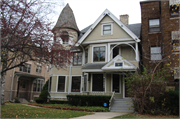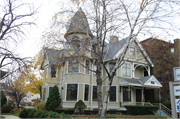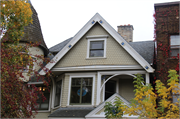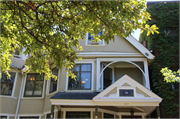Property Record
3127 W WISCONSIN AVE
Architecture and History Inventory
| Historic Name: | William H. Simpson House |
|---|---|
| Other Name: | |
| Contributing: | |
| Reference Number: | 42031 |
| Location (Address): | 3127 W WISCONSIN AVE |
|---|---|
| County: | Milwaukee |
| City: | Milwaukee |
| Township/Village: | |
| Unincorporated Community: | |
| Town: | |
| Range: | |
| Direction: | |
| Section: | |
| Quarter Section: | |
| Quarter/Quarter Section: |
| Year Built: | 1889 |
|---|---|
| Additions: | |
| Survey Date: | 20042014 |
| Historic Use: | house |
| Architectural Style: | Queen Anne |
| Structural System: | Balloon Frame |
| Wall Material: | Clapboard |
| Architect: | Edward Townsend Mix |
| Other Buildings On Site: | |
| Demolished?: | No |
| Demolished Date: |
| National/State Register Listing Name: | Not listed |
|---|---|
| National Register Listing Date: | |
| State Register Listing Date: |
| Additional Information: | A 'site file' exists for this property. It contains additional information such as correspondence, newspaper clippings, or historical information. It is a public record and may be viewed in person at the Wisconsin Historical Society, State Historic Preservation Office. RICHARD RIESEN WAS THE BUILDER. William Simpson was the superintendent of the Northwestern Fuel Company. Previously surveyed in 1984 with map code 10/23. Map name was LUQS 401. 2015- "The Simpson House, located at 3127 W. Wisconsin Avenue, is a former residence that is now an attorney's office. The building is situated on a long and narrow lot that faces north onto the street. Its setback is similar to those of surrounding buildings and includes a grass terrace, sidewalk, and lawn with mature trees. A wide concrete walkway leads to an off-center entrance within the front porch on the west side of the building. It splits off into a smaller path lined with low vegetation that winds around the east side of the house to what currently serves as the main entrance. On the northeast corner of the lot a small , modern sign made of wooden posts advertises the law firm that currently occupies the building. A rear parking lot is accessible via an alley that connects to North 32nd Street on the west side of the block. The original carriage house (AHI No. 113788) that stood at the rear of the house was demolished sometime after 1984. The two-and-one-half-story, Queen Anne house was designed by architect Edward Townsend Mix for William H. Simpson, the superintendent of Milwaukee's Northwestern Fuel Company, and constructed in 1889. It stands on a dressed limestone foundation, is clad in wood, and features a hip and gable roof with asphalt shingles that accommodates its irregular massing. Windows are a combination of wood, one-over-one, double-hung sash and fixed lights with decorative transoms, and some display original stained-glass headers and wood surrounds. Cladding includes narrow clapboards on the first story and scalloped and squared shingles on the second and third stories. The house displays several character-defining features of the Queen Anne style, including a variety of original cladding materials, asymmetrical one-story porch, cutaway bays, and corner turret. The north (main) facade has a prominent front gable. Its pediment incorporates a central Queen Anne glass window, half cove shingles, and decorative vergeboards with prominent blue medallions. A two-story cutaway bay is capped by a denticulated cornice that continues along the top of a recessed second-story porch framed by a full wooden arch and spindle brackets. The house retains its original double wood door on the west end of the facade. It is accessed by a partial one-story porch with a shed roof and tympanum featuring a sunburst design that is held up by non-original balustrades and spindlework supports. The northeast corner features a prominent conical turret with an integrated two-story box bay capped by a modified mansard roof. It is clad in alternating bands of clapboard and squared and fish-scale shingles. The tower's third-story recessed porch has a turned balustrade and arches with squared columns, vegetal entablature, and spandrel details, and is capped with a wood shingle roof. A single hip dormer with a Queen Anne glass window is tucked between the turret and prominent front gable. The east (side) elevation contains a decorative whitewashed chimney, a two-story cutaway bay with a cross-gable pediment similar to that on the facade, and a small shed-roof porch where the building's current primary entrance is located. The west (side) elevation is immediately adjacent to an apartment complex and has no visible features from the exterior. Aerial images show what appear to be three dormers, and two elaborate stained-glass windows along the west wall are visible from the interior of the house. The south (rear) elevation has a small central vestibule with a shed roof and rear door with a transom . An adjacent historic-age addition with vertical wood cladding and a shed roof stands to its east. Two double-hung sash windows with original wood surrounds are located in the center of the wall, one in the gable and one just below it. Interior The interior layout of the residence is largely intact. See the attached floorplans from the 1985 office conversion for the current configuration (original room names have been added if known). The first floor features an original entryway and foyer with wood built-ins, a double-sided fireplace, and a grand staircase with gingerbread fretwork, turned banisters, a carved newel post, and a glazed stained-glass window with two main lights and a three-panel transom on the landing. A servant's staircase is located at the rear of the house. Also on the first floor are a sitting room , parlor, and dining room that incorporate original wood moulding, cabinetry, arched entryways, and pocket doors. Four intact fireplaces remain, which attach to two exterior chimneys. The second floor has a central hall that leads to four former bedrooms that are now used as offices. Some minimal changes were required to convert the house into an office, including the renovation of a kitchen on the south end of the first floor to an office, bathroom, and copy room; the addition of a staircase between the second and third floors; and the conversion of the third floor into a library and filing room." -"William H. Simpson House", WisDOT #2190-00-00, Prepared by Mead & Hunt, Inc. (2015). 2014- "The William H. Simpson House is a two-and-one-half-story, frame, Queen Anne residence designed by well-known Milwaukee architect Edward Townsend Mix and constructed in 1889. It has an irregular plan, rests on a raised limestone foundation, and is clad in clapboard and a variety of wood shingles. It has a cross gable roof clad in asphalt shingles. A large brick chimney is centered on the roof. A wide, front-facing gable dominates the main (north) facade. The gable end is clad in wood fishscale shingles and has simple vergeboards. At the center is a small, multi-paned, double-hung sash window; it has a relatively simple window surround with dentil moldings along the lintel. The main facade has a one-story porch with a shed roof with a front gable, supported by turned columns. A carved sun motif is located in the pediment above the porch entrance. The porch roof supports a small sleeping porch on the second floor that has a decorative semi-circular arch. A three-story tower with a round roof is located on the northeast corner of the house. Windows at the center of the first and second stories are fixed picture windows with transoms. Windows on the other sides of the tower are one-over-one, double-hung sash. Windows on the facade are a mix of various sizes and configurations. William Simpson moved to Milwaukee in 1877 to work for the Northwestern Fuel Company, soon becoming the superintendent. In 1889 he commissioned Edward Townsend Mix to design his residence. Mix was the leading architect in Milwaukee after the Civil War, and designed both public buildings such as the Mitchell Building on East Michigan Street, and homes such as the Alexander Mitchell Mansion (now the Wisconsin Club) on Wisconsin Avenue. The Simpson House was designed and constructed during the latter part of Mix’s career in Milwaukee. By the following year, he moved to Minneapolis, where he spent the rest of this life." -"W Wisconsin Ave, 20th St-35th St", WisDOT #2190-00-00, Prepared by Mead & Hunt, Inc. (2014). |
|---|---|
| Bibliographic References: | MILWAUKEE HISTORIC BUILDINGS TOUR: WEST END, CITY OF MILWAUKEE DEPARTMENT OF CITY DEVELOPMENT, 1994. Tax program. Building permit. Milwaukee City Directory (1900). 2014 (1) City of Milwaukee, Department of City Development, "West Side Neighborhood Historic Resources Survey," Prepared for the City of Milwaukee (September 1984), 12-42, 12-43. (2) Landscape Research, “Built in Milwaukee: An Architectural View of the City,” Prepared for the City of Milwaukee (1981), 140. |
| Wisconsin Architecture and History Inventory, State Historic Preservation Office, Wisconsin Historical Society, Madison, Wisconsin |





